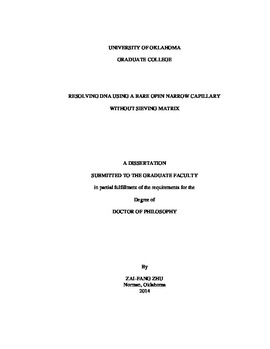| dc.description.abstract | DNA molecules encode the hereditary information utilized in all living organisms, including humans. Separating DNA fragments is essential in biological research because it informs us how DNA molecules work and eventually guides us to solve related problems based on DNA examinations. Agarose gel electrophoresis (AGE) and capillary gel electrophoresis (CGE) are the two most-widely used techniques for DNA separations. While these two techniques are capable of resolving DNA fragments nicely and efficiently, the use of viscous gels results in many issues, such as time-consuming gel preparation and tedious operations. To address these issues, our group recently developed a technique for gel-free DNA separations. As this technique was carried out in a bare narrow capillary and separations were majorly based on hydrodynamic chromatography, it was named Bare Narrow Capillary-Hydrodynamic Chromatography (BaNC-HDC). The objective of this dissertation is to develop a miniature and automatic BaNC-HDC system for rapid and high-throughput DNA separations without using any sieving matrix.
We first proposed a new configuration of electroosmotic pumps (EOPs). In this new configuration, a basic EOP unit was composed of a +EOP and a –EOP. The pump capillaries used in +EOP were derivatized and the inner surface was positively charged. In –EOP, bare capillaries were used and the inner surface was negatively charged. In practice, high voltage was applied to the junction of +EOP and –EOP while both the inlet and outlet were grounded. With this configuration, we stacked ten open-capillary EOP units in series to boost the pressure, and a pumping pressure of up to 21.4 MPa was achieved. The performance of the constructed ten-unit EOP was evaluated by applying it to drive high performance liquid chromatography for separations of peptides or proteins.
We then explored the resolving power of BaNC-HDC and presented the extremely high efficiency of BaNC-HDC for DNA separations. By manipulating the elution velocity, efficiency of more than one million theoretical plates per meter was easily obtained. Through studying the relationship between the elution velocity and the height equivalent to a theoretical plate, we revealed the unique behaviors of BaNC-HDC in van Deemter curves. The effect of temperature on DNA separations in BaNC-HDC was also investigated.
In order to automate injections in BaNC-HDC, a microfabricated chip injector was developed. The chip injector was composed of an on-chip cross and an off-chip six-port valve, and it was able to deliver picoliters of sample reliably and reproducibly. By integrating this chip injector and the developed EOP into the BaNC-HDC system, the separation of GeneRulerTM 1-kbp plus DNA ladder was accomplished within five minutes and plasmid DNA was accurately sized.
To improve throughput in BaNC-HDC, a splitting-based chip injector was developed. With the new injector, injections could be performed while the separation was in process, and this facilitated successive injections in BaNC-HDC. Throughput of BaNC-HDC was improved from six to fifteen samples per hour. Additionally, the injected volume can be precisely controlled at the subpicoliter level, and, for large DNA fragments, only molecules of DNA were required for each assay. The developed system was successfully applied to sizing digested λ-DNA, and all six fragments were identified within ten minutes. We also utilized the system to investigate the genetic diversity of Saccharomyces cerevisiae (S. cerevisiae) strains with short tandem repeats as markers. Short tandem repeats from two yeast strains, BG-1 and CAT-1, were resolved and distinguished within ten minutes. | en_US |
